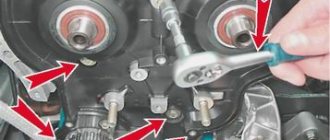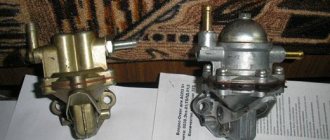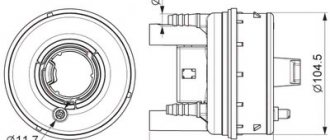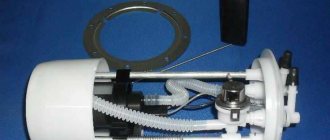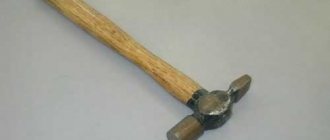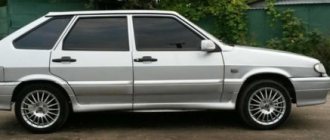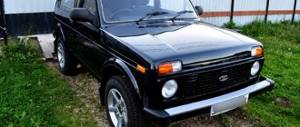HOW THE FUEL SYSTEM WORKS
Fuel is supplied to the ramp under excess pressure (6 atmospheres), which is created by the fuel pump. Using the pressure regulator on the nozzle, a constant pressure drop of 3 atmospheres is maintained. At constant pressure and a linear characteristic of the injectors, the amount of fuel injected is determined by the duration of the injector control pulse.
This is a theory. On a real engine, the pressure drop can be from 2.8 to 3.2 atmospheres. This is an acceptable range within which no deviations in engine operation are observed. Why is pressure variation possible? It is determined by the spread in the characteristics of pressure regulators.
HOW TO CHECK THE FUEL SYSTEM?
Let's connect the pressure gauge to the fuel rail. With the fuel pump turned on and the engine not running, the pressure should be 2.8-3.2 atmospheres. If the engine is idling, the pressure should drop to 2.2-2.5 atmospheres. When over-gassing, the pressure gauge needle should deviate into the zone of 2.8-3.2 atmospheres.
Now let's check the operation of the injectors. With the engine not running, we will create the required pressure in the ramp (2.8-3.2 atmospheres), after which, using diagnostic equipment, we will apply a series of test pulses to the first injector, monitoring the change in pressure. The above procedure must be carried out for all injectors. The pressure drop should be the same in all cases. If the results of checking the fuel pressure correspond to those described above, the fuel supply system is working properly.
What will happen if the fuel pressure in the rail is low (less than 2 atm.) or high (more than 4 atm.)? The amount of fuel injected will change in proportion to the pressure deviation from the norm. In other words, the air-fuel mixture will become lean or rich.
It will be especially painful in engine control systems without oxygen sensor feedback, since the controller does not know about the malfunction and continues to calculate the fuel supply for a normal fuel pressure value. In control systems with an oxygen sensor, the controller can compensate for changes in the composition of the air-fuel mixture, but only within reasonable limits.
If the fuel pressure is incorrect, problems arise with starting the engine, dips appear when the vehicle moves, and fuel consumption increases.
Parameters of the Bosch model 0580453453
If you are interested in a VAZ 2110 Bosch fuel pump, the characteristics of the models will differ in the length and sometimes in the diameter of the body. The diameter of the body is adjusted using a gasket made of gas-resistant rubber. Also, devices may differ in pressure, placement of chips on the terminals. The device grid does not differ in the number of seats, but may vary in shape. You can remake the chip for a terminal or install it from a VAZ car. The length of the fuel pump determines its performance when the volume of fuel in the tank is low. If it is located in a module, then compliance is required to install it. The length of the Bosch model 0580453453 is 105 mm, 0580453449 is 65 mm, and for Bosch 0580453465 this figure is 90 mm. The pump is located in the car tank, it is immersed in fuel. It contains an electric motor that drives the pumping element. A combination of these components supplies fuel under high pressure. As a result, the fuel pump is noisy and needs cooling. Therefore, the equipment is immersed in a tank of fuel, as it serves as a coolant and noise-insulating compound.
Read more: Fine for overloading a passenger trailer
FINDING FUEL SYSTEM MALFUNCTIONS
Let us recall the composition of the fuel supply system. It includes: a fuel tank with an installed submersible fuel pump, a fuel filter, fuel lines (supply and drain lines), an injector ramp and a pressure regulator. Any component failure can cause incorrect fuel pressure. Let's try to list common faults for each component.
Gas tank. Through special pipelines, the gas tank communicates with the atmosphere, which prevents its deformation (flattening). If the connection with the atmosphere is broken, a vacuum is created inside the gas tank. In this case, the pressure in the fuel rail may be low.
Gasoline pump. There are several malfunctions:
- the fuel pump does not develop the required pressure, resulting in low fuel pressure;
- the check valve of the fuel pump does not hold pressure, as a result - a rapid drop in pressure after turning off the ignition;
- contamination of the fuel pump mesh filter, as a result - reduced pump performance, which affects the dynamic operating conditions of the engine.
Fuel filter. A dirty fuel filter can lead to low fuel pressure due to reduced fuel line capacity. If the fuel filter is damaged (torn), dirt can enter the injectors with all the ensuing consequences.
Fuel lines. Fuel lines may be pinched. If this happens to the supply line, then the fuel pressure will be reduced, if it happens to the drain line, it will be increased. In addition, the use of low-quality gasoline with a high tar content can lead to a decrease in the capacity of fuel lines.
Fuel pressure control. There are regulators with a stuck diaphragm in the open or closed position. In the first case, the fuel pressure in the system will be reduced, in the second - increased.
Injectors. The following types of faults are typical:
- the injector does not open, resulting in a lean air-fuel mixture;
- the injector is constantly open, resulting in an enriched air-fuel mixture;
- the injector works, but its characteristic has “floated away”, as a result - the air-fuel mixture is incorrect.
Pumps and injectors from Bosch: tables
The most famous manufacturer today. Pumps from Bosch are installed on many well-known car models.
The electric fuel pump from Bosch uses a high power rating, which allows it to push fuel directly onto the injectors and into the power plant. The operation of this fuel supercharger is controlled electronically. It calculates the state of the damper, exhaust and takes into account the amount of gasoline in the fuel assembly completely in AUTO mode.
It is noteworthy that Bosch develops unique pumps for this or that brand of car. For example, for our VAZs, units with a capacity of 3 or 3.8 bar are produced. These figures are higher than those provided for by the car, however, many owners install just this option. The Bosch pump in no way affects the increase in fuel consumption, as some believe. On the contrary, fuel consumption is caused by a situation when optimal pressure is not created in the ramp, and as a result, the injectors do not function correctly - they do not spray gasoline, but simply pour it.
Read more: How to use the Mercury Ta 001 tachograph
Thus, Bosch pumps can have different performance data. It all depends on the specific analogue. Read more in the table, which shows the types of fuel pumps by model.
| Bosch fuel pump model | System pressure max, kPa | Capacity l/h |
| 0 580 254 005 | 500 | 168 |
| 0 580 254 040 | 650 | 102 |
| 0 580 254 044 | 700 | 172 |
| 580453978 | 300 | 95 |
| 580453979 | 300 | 103 |
| 580453980 | 400 | 103 |
| 580453981 | 300 | 85 |
| 580453982 | 400 | 103 |
| 580464008 | 300 | 130 |
| 580464031 | 300 | 140 |
| 580464061 | 310 | 180 |
Bosch pumps are also installed on the popular German BMW car in Russia. Performance also varies depending on the BMW model. Basically, it is customary to divide pumps from this manufacturer for BMW into two categories.
| Productivity at rated voltage 95-135 l/h | Productivity at rated voltage 130-195 l/h |
| BOSCH 0 580 254 945 | BOSCH 0 580 464 008 |
| BOSCH 0 580 254 946 | BOSCH 0 580 464 013 |
| BOSCH 0 580 254 950 | BOSCH 0 580 464 014 |
| BOSCH 0 580 254 951 | BOSCH 0 580 464 015 |
| BOSCH 0 580 464 030 | BOSCH 0 580 464 016 |
| BOSCH 0 580 464 034 | BOSCH 0 580 464 019 |
| BOSCH 0 580 464 040 | BOSCH 0 580 464 020 |
| BOSCH 0 580 464 041 | BOSCH 0 580 464 023 |
| BOSCH 0 580 464 032 | |
| BOSCH 0 580 464 033 | |
| BOSCH 0 580 464 038 | |
| BOSCH 0 580 464 048 | |
| BOSCH 0 580 464 050 | |
| BOSCH 0 580 464 051 | |
| BOSCH 0 580 464 056 | |
| BOSCH 0 580 810 046 |
On injection engines, in addition to the pump performance, it is customary to talk about the performance of the injectors. This means their maximum possible throughput when open. In other words, over what period of time the nozzle is capable of supplying the maximum amount of fuel is this very parameter.
As a rule, most manufacturers, including Bosch, Siemens, Denso and Delphi, provide injector sizes in their catalogs according to Western standards, i.e., in f/h.
Here, for example, are the parameters of Bosch injectors according to the catalogue.
The article will be of interest to those who are looking for information about the technical characteristics and performance of the VAZ 2110 gasoline pump. Gasoline engines can be equipped with electrical or mechanical devices. For the VAZ 2110 car, the electric fuel pump of the Bosch brand is the most popular, as it has universal sizes, is always available in stores and is inexpensive.
ON-BOARD DIAGNOSTICS FOR FAULT DETECTION
A malfunction of the fuel system leads to a deviation in pressure in the fuel rail. As a result, the amount of fuel supplied to the cylinders differs from the calculated one, and the air-fuel mixture becomes depleted or enriched. In engine management systems with an oxygen sensor, the controller monitors the current composition of the air-fuel mixture.
If the air-fuel mixture deviates significantly from the desired value, the controller perceives this condition as a malfunction, and one of two fault codes is recorded in the controller’s memory:
- P0171 - fuel system too lean;
- P0172 - fuel system too rich.
Increased or decreased pressure in the fuel rail is just one of the reasons why codes P0171, P0172 can be recorded in the controller’s memory. The cause of a significant depletion or enrichment of the air-fuel mixture may be faulty mass air flow sensors, oxygen sensors, or injectors. Air leaks lead to an over-lean air-fuel mixture.
The fuel pressure value may be outside the permissible range, but the on-board diagnostics does not record anything. It’s a very real situation - on-board diagnostics are not omnipotent.
The best manufacturers of gasoline pumps
There are 5 companies that are considered leaders in the production of gasoline pumps and other elements for the fuel system. All brands differ in the quality of spare parts, as well as in the price segment.
Bosch
Description. The German company Bosch occupies a leading position in the production of aftermarket spare parts. Parts for the fuel system are delivered to the conveyor. Secondary elements do not differ in quality. The main line of gasoline pumps is considered to be the electric version. The company practically does not produce mechanical pumps.
The gasoline pump is reliable and durable due to the use of durable materials in manufacturing. In total, more than 100 models are produced for various car brands.
Performance. The productivity of the units varies from 50 to 180 l/h depending on the model. Most have an average performance of 85.
Life time. The guaranteed operating period is set at 12 months, but with proper maintenance the pump can operate for up to 10 years.
Pros Bosch
- Having a good reputation and brand popularity.
- Possibility to select a pump for any brand of car.
- Large selection of aftermarket parts that do not differ in quality from the original.
- Average price segment with a combination of reliability and high-quality performance.
- Availability of spare parts on the market.
Cons Bosch
- A large number of counterfeits that are of poor quality.
- The need to check all markings and inscriptions to avoid counterfeits.
VDO
Description. The German brand VDO belongs to a large association of companies Continental Automotive GmBH. The manufacturer supplies parts for various well-known car brands, both to the assembly line and to the secondary market. Electric fuel pumps are in great demand due to their long service life and low number of defects.
The pump itself has improved characteristics compared to analogues and is made of high-quality materials, which reduces wear.
Performance. The productivity of different lines varies from 85 to 160 l/h. The average is 100-105 l/h.
Life time. The warranty is issued for 2 years. The duration of operation with the required maintenance exceeds 10 years.
Pros of VDO
- Large selection of fuel pumps that are original spare parts.
- High quality and warranty.
- Low noise level.
- Operational problems are rare.
Cons of VDO
- There are many fakes that lack markings, so it is advisable to purchase parts from trusted suppliers.
- It is necessary to select a device taking into account all the characteristics of the engine.
Pierburg
Description. The Pierburg brand is one of the German companies that entered the global aftermarket aftermarket not so long ago. Gasoline pumps are supplied both for sale to car owners and for assembly of German cars, which makes the parts native to part of the automotive industry.
Among the distinctive properties of the device are almost silent operation and resistance to damage. Another difference is considered to be good protection against counterfeiting with the help of branded imprints and security codes.
The gasoline pump is designed for long-term use, which is confirmed by quality certificates and compliance with the requirements of ISO EIC 27001, ISO 18001 standards.
Performance. The performance of different pump models ranges from 85 to 110 l/h, but there are a number of lines that are produced for sports and powerful cars. Such pumps have increased productivity.
Life time. The pump warranty is set at 2 years, but a number of aftermarket parts are covered for a period of 1 year. The duration of actual operation can exceed 5 years even under difficult operating conditions.
Pros of Pierburg
- Good protection against counterfeiting.
- High-quality workmanship and the use of durable metal that can withstand high loads for a long time.
- No complaints about noise.
- Possibility of choosing among original spare parts, since secondary parts differ little from conveyor parts.
Cons of Pierburg
- High-capacity pump models must be specially ordered through suppliers.
PEKAR
Description. The domestic brand is one of the market leaders in spare parts for the fuel system, in particular fuel pumps. The lines are aimed at the Russian auto industry. Deliveries are carried out on a conveyor belt, which means that all certificates are available and standards are met.
The company produces various versions of gasoline pumps, which are distinguished by their affordable price and good quality. The pumps have no defects and are resistant to mechanical stress.
If necessary, you can find mechanical and electrical models for any car.
Performance. Performance depends on the pump model. For older lines it is 80-100 l/h, and for new ones it exceeds 170. Since the range is large, it is possible to select a pump with the required performance for any engine.
Life time. The warranty is issued for 1 year. The duration of operation with careful treatment of the system unit and timely maintenance exceeds 10 years.
Pros of PEKAR
- Small price.
- Availability and large selection of all types of pumps.
- High-quality work with high productivity and absence of defects.
- A small number of fakes.
- Maintainability and easy installation due to durable connectors and reinforced fasteners.
- Low noise levels.
Cons
- May overheat if installed incorrectly without taking into account engine power.
Meat&Doria
Description. The Italian brand is popular due to its high-quality products, including gas pumps. There are more than 100 types of pump models, which makes it possible to choose the best option for any engine. Production is subject to European and international quality regulations.
The difference is considered to be the ability to detect counterfeits by reading codes and branded elements on spare parts. On the aftermarket parts market, gasoline pumps from the Italian company are considered one of the best, since the spare parts have a combination of quality and a simplified installation and maintenance option.
Performance. The performance of different series of pumps varies from 85 to 150 l/h. They also produce special gasoline pumps with increased performance, which are used in sports cars.
Life time. The standard warranty is issued for 1 year. Duration of operation without interruptions and repairs exceeds 7 years. But this option is only possible with proper maintenance and taking into account the characteristics of the engine during installation.
Pros of Meat&Doria
- Good value for money.
- A large selection of different options for fuel pumps for domestic and foreign car brands.
- There are no complaints about operation and installation, since the pump can be repaired.
Cons of Meat&Doria
- There are better pump models in the price category.
- Noisier operation compared to well-known competitors.
